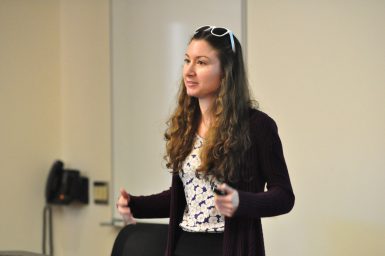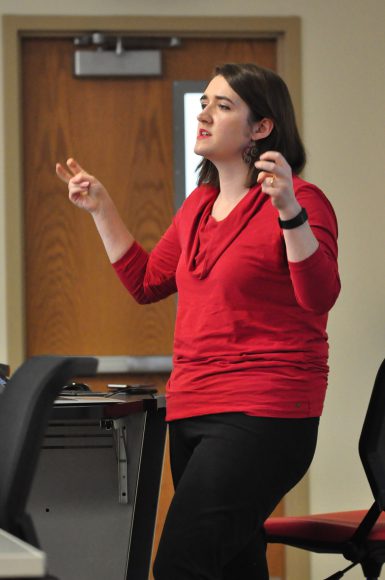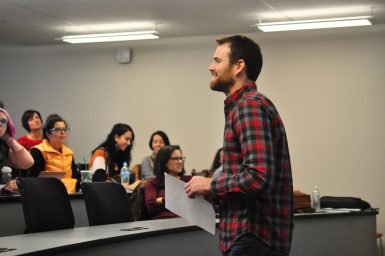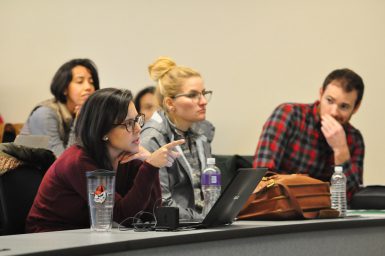Doctoral students present research at weekly colloquium

Four doctoral students shared previews of their talks for an upcoming national conference during the school’s Friday research colloquium.
Iris Bull, Cole Stratton, Edo Steinberg and Jess Tompkins presented their work as a practice session for the National Communication Association conference Nov. 10-13 in Philadelphia.
Tompkins kicked off the session with “Visual Vixens and Virgins in Japanese and North American Video Games,” which compares salient attributes of female characters in American and Japanese games.
She explained that sexism in these games could be noted both through hostile and benevolent themes of sexism. Two emergent themes came from the research.
“One of these themes was the idea of bodies as objects and weapons—this idea that these characters are all impressive and capable fighters, but they’re often objectified at the same time,” Tompkins said.
She noted the idea of (in)dependence as a second theme found in the games.
“Many of the characters were part of a cooperative team with other characters,” she said. “During gameplay, they often had other characters who assisted them.”
Tompkins said this theme was not necessarily exclusive to female video game characters, but it was a notable aspect of her research.
She will present her research in the five-minute, scholar-to-scholar portion of the conference with a one-page PowerPoint to assist with visuals.

Bull presented “’She Preys on Other Women, but She’s Still a Staunch Feminist’: The ‘Feminist’ Production Culture of Strange Empire.” Strange Empire, a Canadian television program, ran for one season and has since moved to Netflix.
Bull analysed the character Kat Loving.
“Whether or not this work is ‘capital F feminist’ is not addressed in this paper, nor do I anticipate it ever to be in my work,” Bull said.
Rather, Bull analysed how language is used in the show and how Loving is portrayed in the program to reflect feminist elements.
“Instead, I argue that we should consider how language and media practices codify reprouceable elements that technological imagination can play with.”
Bull’s research will be presented in the form of a 20-minute presentation with a PowerPoint.
Doctoral student Cole Stratton followed Bull with his research, “Being as Working: The Mobile Image Interface and Perceptual Capture in Modern Capitalism.”
Stratton introduced the smartphone as a form of commercial product in a way that many users may not typically consider it.
“Consider, for instance, that this is a market research tool that produces all kinds of data about our everyday lives,” he said. “It’s an advertising space that we take with us wherever we go, and it occupies a considerable amount of our attention.”
Stratton explored in his research how the smartphone’s interface is productive to capital.

“The fact that all these elements are contained within one personal device is, I think, something historically unique and quite significant,” he said. “This has led me to see the smartphone as a very important nexus where these forces all lead and where we meet these forces.”
Stratton’s research will be presented in the form of a 12-minute talk in a panel on visual and virtual technologies of behavior.
Last to present was doctoral student Edo Steinberg with his research talk, “Consensus of Fake News: An Automated Content Analysis of Jon Stewart and Stephen Colbert.”
Steinberg analysed pre-coded coverage of Jon Stewart’s The Daily Show and Stephen Colbert’s The Colbert Report to note main topics of discussion on the programs. He also questioned whether certain topics were covered more in election years than in non-election years, and whether pop culture topics decreased in coverage over time.
The results were not necessarily what may have been expected, according to Steinberg.
“Animals, drugs and kids, for some reason, are among the main topics on the show, which I wouldn’t expect. Animals and drugs don’t show any patterns, but kids—they start talking about kids more, starting in 2010.”

Some results didn’t show consistent trends, the data indicated. An analysis of substantive coverage versus pop culture references reflects this.
“We expect some sub to go up, some to stay about the same. For some reason, movies go up over the years, and other cultural things go down, go up. So it’s all over the place.”
Steinberg will present his research in the form of a seven-minute talk with no visual posters or PowerPoints.
All four students will be joined by other students and faculty at the NCA annual conference Nov. 10-Nov. 13. The conference takes place in Philadelphia this year.
More:

